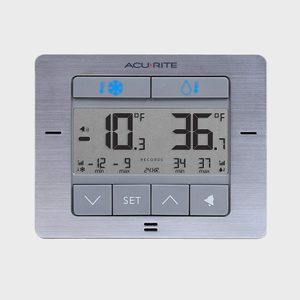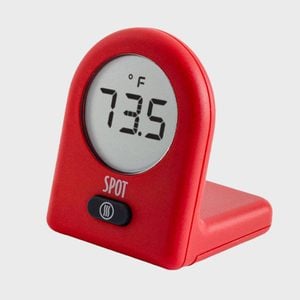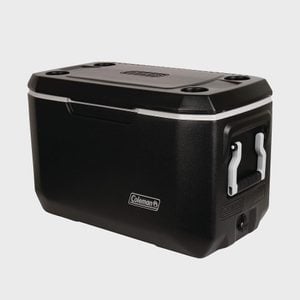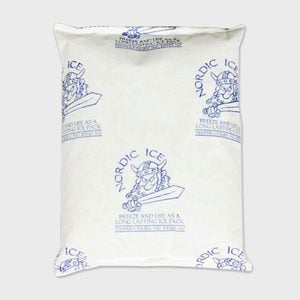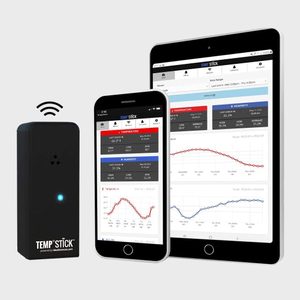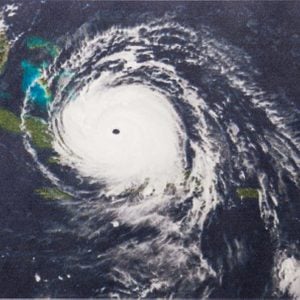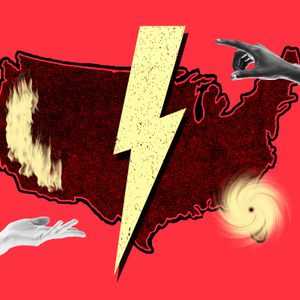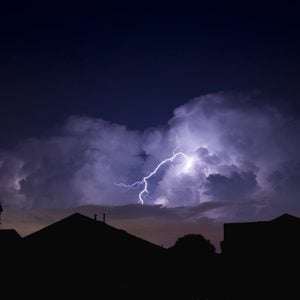Does Putting a Quarter on a Cup of Frozen Water Before a Major Storm Actually Work?
Updated: Jun. 28, 2023
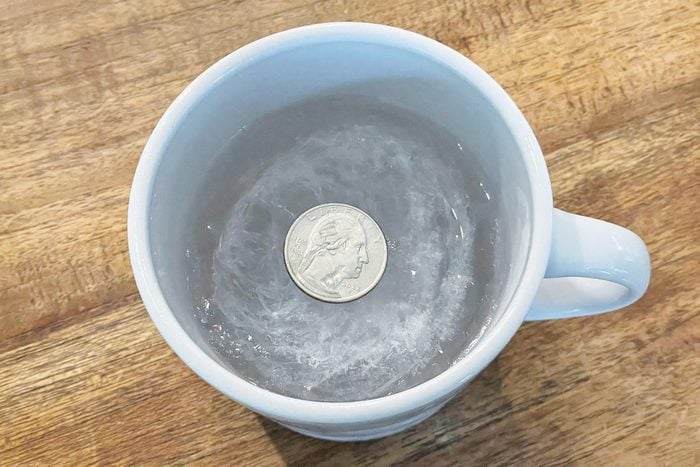
Putting a quarter on a frozen cup of water is a simple storm-preparation trick, but can it really determine food safety? We investigate.
During a hurricane, tornado, wildfire or other event, protecting yourself and your loved ones is always the first priority. But the lasting effects of severe weather can be just as dangerous as the storm itself—sometimes even more so. For that reason, it’s crucial that you know how to prepare for a hurricane, how to prepare for a tornado and what to do when the power goes out. After all, if your home loses power, the food in your fridge is at risk of going bad pretty quickly. According to the internet, there’s a simple trick—putting a quarter on a frozen cup of water—that can help you figure out if the food in your fridge is still safe to eat, even in the wake of the strongest hurricanes.
But just how accurate (and safe) is that advice? We talked to food-safety experts to find out.
Get Reader’s Digest’s Read Up newsletter for humor, cleaning, travel, tech and fun facts all week long.
Why do some people put a quarter on a frozen cup of water before a storm?
Maybe you always thought the “quarter on a frozen cup of water” thing was an old wives’ tale. Or maybe, like us, you first heard about it in 2016, when a Facebook post explaining the tip went viral.
In her post, Sheila Pulanco Russell explained the setup:
- Place a cup full of water in your freezer.
- Once it’s entirely frozen, put a quarter on top of the ice.
- Leave the cup—with the quarter—in your freezer when you head out the door for evacuation.
You might already know where we’re heading with this. Upon returning home, pull the frozen cup out of your freezer. “When you come back after you’ve been evacuated, you can tell if your food went completely bad and just refroze or if it stayed frozen while you were gone,” Russell writes. “It would also be a great idea to leave this in your freezer all the time, and if you lose power for any reason, you will have this tip to fall back on.”
What can you learn from the quarter trick?
Proponents of this tip say it’s a good way to gauge whether the contents of your freezer stayed frozen during a storm. All you have to do is spot the quarter in the cup.
- If the quarter is on top: The contents of the freezer stayed frozen and are safe to eat. The power likely didn’t go out.
- If the quarter is in the middle: The contents of the freezer likely began to thaw when the power went out and then refroze quickly. You’ll want to check each container of food to be certain.
- If the quarter is at the bottom: The freezer fully defrosted and the food thawed. Assume the food’s unsafe to eat and throw it out—it could induce food poisoning.
Is this a safe way to test frozen foods after a power outage?
You can’t believe everything you read on the internet, so Reader’s Digest reached out to food-safety experts to find out whether placing a quarter on a frozen cup of water—aka the one-cup tip—actually has validity. We wanted to get to the bottom of the cup and find out: Is this tip actually effective in predicting food safety? Or should you use other methods to determine if food is safe to eat?
“The quarter trick is cute but doesn’t tell you how long the power was out,” says Marion Nestle, PhD, the Paulette Goddard professor of nutrition, food studies and public health at New York University. “The rule of thumb is ‘When in doubt, throw it out.'”
One big reason the hack isn’t as useful as it sounds? Frozen items thaw at different speeds. Think about it: That block of ice isn’t going to melt in the same time frame as frozen steak, which has an entirely different makeup. That means there’s a significant margin of error. It’s possible that certain foods may go bad before the ice melts.
So even with this trick, you’ll want to go through your freezer and assess any potential damage. And as Nestle recommends, chuck anything you’re unsure about.
Another thing to keep in mind: “There are a lot of other factors that go into food safety, but thawed food isn’t necessarily an indicator that the food is bad, but might be an indicator that you need to use it soon,” explains food expert Trevor Craig, corporate director of technical training and consulting for Microbac Laboratories.
Kelsey Lorencz, RDN, nutrition advisor for Zenmaster Wellness, agrees. “Some foods may still be safe to eat even if your quarter is more than halfway down the cup or you know that the temperature has risen above 32 degrees,” she says. “Frozen pastries, breads, fruit and vegetables are likely safe, but the quality may not be as good. Foods that should be tossed out to avoid illness include any meat, fish or poultry [raw or precooked] and prepared foods like freezer meals.”
So, should you try it?
Maybe, but it shouldn’t be your only way of determining food safety. It’s a good place to start, though.
“It’s not an FDA-approved way to determine the safety of your food, but if you’ve been gone several days and your clocks are blinking but the quarter is still at the top of the cup, it’s likely that your power wasn’t out long enough to affect the safety of the food,” says Lorencz.
Craig considers it a good first clue that you need to pay attention to your frozen foods. “This is a good way to see if your freezer is working or stopped working,” he says.
But it probably shouldn’t be your only food-safety clue. It’s hardly foolproof, and that means potential foodborne illness is on the line. Fun as the hack may be, you need to ask yourself, Do I really want to risk it?
One thing all the food experts we spoke to agreed on is that when it comes to your health, food safety is not worth the gamble. So use the tip as a starting point, then inspect further.
What are other ways to make sure your food is safe after a storm?
While the one-cup tip can provide some insight, don’t think of it as law. Instead, consider it a gateway to exploring the safety of your food in other ways. And take the necessary steps to ensure food safety for the next big storm.
What to do after a power outage
You’ve just been through an ordeal. After a natural disaster or storm, the power will come back on, and you’ll be eager to find out just how much of your frozen food is still safe to eat. Follow the tips below for helpful steps to take.
Check food temps
Start by checking the temperature of frozen food items with an appliance thermometer. “You can safely refreeze or cook thawed food that still contains ice crystals or is at 40 degrees or below,” according to the Centers for Disease Control and Prevention.
Anything above 40 degrees? Toss it in the garbage (or compost).
Craig sets even stricter temperature guidelines. “Freezers are designed to keep things frozen, which seems obvious, but most freezers are far below the freezing point of water,” he explains. “This allows the products to completely stay frozen throughout and helps buffer with opening and closing.”
He points out that freezers are typically set to zero degrees (or -18 degrees Celsius). Just because water remains frozen at 32 degrees (or zero degrees Celsius) doesn’t mean that’s the best temp for your food. Some freezer items may require lower temperatures because they’re made up of a lot more than water. “I would not risk anything that rises above 5 degrees Fahrenheit,” Craig says.
Check for physical changes
After a power outage, give your food a good look. “You can check your food to see if there are physical changes or if any water is gathered on the resting side,” Craig says. “As the product thaws and water pools, it could also refreeze in that pool.”
Notice physical changes or pooled water? Discard that item, Craig says. According to State Food Safety, food that has thawed and then refrozen in a pool of water is no longer safe to eat because it’s more susceptible to an increase in bacteria.
“It’s also important to note that bacterial contamination and growth isn’t usually visible,” Craig explains. “It might smell or look different, but it might not, so relying on your senses is risky.”
Avoid the taste test
Spoiled food tastes bad, but that’s no reason to nibble your way through your freezer. The CDC implores people to never taste food as a way to determine if it’s safe. Doing so will put you at risk for foodborne illnesses.
When in doubt, toss it out
If the power goes out, discard any food that has been out of the appropriate temperature for two hours or more—especially meat, poultry and seafood. The same goes for food that has completely thawed or warmed to room temperature, according to the University of Minnesota Extension.
Here’s a handy way to determine whether you should eat a thawed item: Look at the cooking instructions. Do they advise cooking the item raw, directly from its frozen state? If so, and if it’s reached a higher-than-frozen temp, toss it in the trash. Do they allow for thawing before cooking? These may be safe to eat.
“Items that can be thawed before cooking or consuming might be acceptable, but remember, they should still be refrigerated and probably should be prepared soon after thawing,” says Craig. “Once they warm up, bacteria growth could start immediately.”
Consider, too, which items thawed—and the risk they may have posed to other foods, particularly if they’re not tightly sealed in food-storage containers. “If everything you have has thawed, your frozen meat, for example, could have dripped onto everything,” he says. “It’s a very risky process, as it could cross-contaminate if the other products aren’t tightly sealed. If your products are out of temp, it’s not worth the risk.”
If you’re really unsure, you can call the U.S. Department of Agriculture’s Meat and Poultry Hotline at 888-MPHotline (888-674-6854).
How to prepare for the next power outage
As helpful as it may be to put a quarter on a frozen cup of water, there are plenty of other reliable ways to make sure your food is safe after a storm. Take the steps below to keep your frozen foods safe the next time your power goes out.
Use a thermometer
The most crucial part of determining food safety is the freezer’s temperature and assessing how much the freezer varied in temperature while the power was out. The CDC recommends making sure your freezer (and fridge) doors are tightly shut; that way, food will stay safe for up to 48 hours in a full freezer and 24 hours in a half-full freezer.
Beyond that, invest in a good thermometer. “You can also buy appliance thermometers that monitor max temps read over a period of time,” Craig says. Bonus: They’re fairly inexpensive.
Keep coolers on hand
According to the CDC, preparation is a crucial part of food safety. “For keeping food cold if the power will be out for more than four hours, have a couple of [coolers] on hand, along with frozen gel packs,” its website suggests.
Practice smart storage
A well-stocked freezer is great for last-minute dinners and keeping foods cold. Organize your freezer with frozen foods tightly packed whenever possible. According to the CDC, “when your freezer is not full, keep items close together. This helps the food stay cold longer.”
Let tech do the hard work
In the market for a new freezer? Invest in an appliance with a built-in freezer alarm. That’s right: Some of the best freezers will let you know when the temperature rises too high.
Sources:
- Marion Nestle, PhD, MPH, Paulette Goddard Professor of nutrition, food studies and public health at New York University
- Trevor Craig, corporate director of technical training and consulting with Microbac Laboratories
- Kelsey Lorencz, RDN, nutrition advisor for Zenmaster Wellness
- Facebook: Sheila Pulanco Russell
- University of Minnesota Extension: “Refreezing food”
- State Food Safety: “Is it okay to refreeze food?”
- USDA: “Keeping Food Safe During an Emergency”
- Journal of Food Science: “Changes in broiler breast fillet tenderness, water-holding capacity, and color attributes during long-term frozen storage”
- Colorado State University Extension: “If Your Freezer Stops”
- CDC: “Food Safety for Power Outages”

